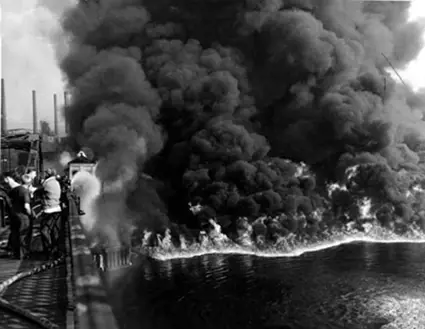President Nixon as Midwife for the Birth of Enviromental Law - June 2016
By Jim Lang - June 2016
Whether he actually said it or not, Winston Churchill gets credit for the quote that “Americans will always do the right thing, only after they have tried everything else.”

Cuyahoga River Fire Nov. 3, 1952. Courtesy of Special Collections, Michael Schwartz
Library at Cleveland State University (from the Cuyahoga River – Fires, Accidents Collection)
When deciding how much pollution may be released into our surroundings and whether there should be a financial charge for the privilege of releasing pollution, Americans indeed did try “everything else” for a very long time. No one liked the results, except perhaps those who over a period of two centuries benefited from the privilege of releasing their pollution free of charge. In the 1950’s and 60’s the people of Los Angeles were breathing some of the dirtiest air in the world. When a smog attack hit Los Angeles during World War II, serious inquiry was made to determine whether the Japanese had launched a chemical attack on the city. In January 1969, a “blowout” at a Union Oil Company oil platform six miles offshore in the Pacific Ocean released 200,000 gallons of crude oil over an eleven-day period. The oil marred 35 miles of coastline near Santa Barbara, California. In June 1969, the Cuyahoga River burst into flames in Cleveland, Ohio, after sparks from a passing train set fire to oil-soaked debris floating on the surface of the water. The photo above shows the Cuyahoga River on fire in 1952, one of the many times that the river caught fire because, as suggested in the quote attributed to Winston Churchill, Americans are known for trying “everything else” before settling on “the right thing”.
During the two centuries when Americans were trying “everything else” producers of goods, and the consumers of those goods, had grown quite accustomed to releasing their waste wherever they pleased, no matter how toxic, at will, free of charge, no matter the financial cost imposed on others, which cost came about in the form of illness (think cancer or asthma from smog), lost employment (think reduced employment for watermen when pollution destroys the oyster or crab population in the Chesapeake Bay), and reduced value for private property (think plummeting value of waterfront land on the Cuyahoga River after the fire). Goods were selling at artificially low prices, and this anomaly would continue until the price consumers paid for goods included the cost to dispose of the waste generated during production.
The late 1960’s and early 1970’s brought the first meaningful steps to end the free disposal of waste into our surroundings. 1972 was the year that President Richard Nixon signed the Clean Water Act into law, preceded in 1969 and 1970 by his signing of the National Environmental Policy Act and the Clean Air Act, respectively, into law. President Nixon’s midwifery of environmental law came to an end with his departure from office in 1974. The next significant piece of environmental legislation, the Resource, Conservation and Recovery Act, was signed into law by President Ford in 1976.
Jim Lang, a Pender & Coward shareholder, focuses his practice on water and environmental law.
Contact him with questions by calling (757) 502-7326 or by sending an email to jlang@pendercoward.com .